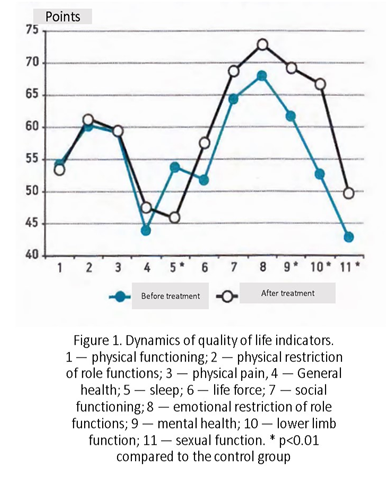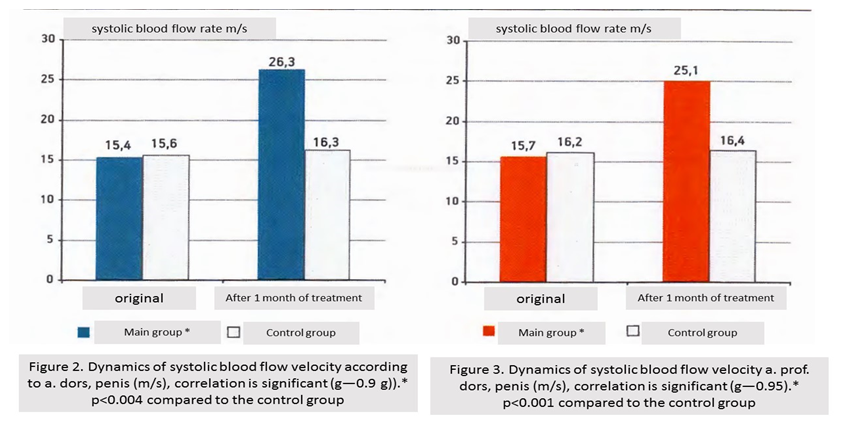The leading cause of obliterating arterial pain is atherosclerosis, which accounts for up to 80-90% of cases. The main pathogenetic mechanism is endothelial dysfunction, which is aggravated by hypertension, diabetes, congestive heart failure. The desire of modern society to improve the quality of life has led to increased interest in the problems of human health in general and sexual health in particular, as erectile function is an important factor in the quality of life, which makes it necessary to seek more effective methods of diagnosis, treatment and rehabilitation of patients. The aim of this work is to assess the effectiveness of vasoactive peptide on 41 patients suffering from vasculogenic erectile disfunction as one of the manifestations of atherosclerosis. The comparative analysis of clinical and instrumental parameters found that the blood flow in the main arteries of the penis before and after the course of monotherapy with the medicine significantly improved both in the clinical picture as well as in objective terms.
It is well known that diseases of the cardiovascular system caused by atherosclerosis are extremely widespread. Impotence, or erectile dysfunction (ED), as a signal symptom is often one of the first manifestations of atherosclerotic lesions of the aortoiliac vascular segment. This is confirmed by the results of studies that showed an increase in the likelihood of patients with ED signs of coronary heart disease CHD, the worst state of systemic endothelial function in this group of men, as well as an increase in their risk of cardiovascular complications. It should be noted that all these facts relate only to the arteriogenic form.
- Impotence is a long-term (not less than 6 months) inability of a man to achieve and maintain an erection sufficient for satisfactory sexual activity.
Until the middle of the XX century, ideas about the physiology and pathophysiology of erection were extremely scarce, and the treatment of erection disorders was mainly engaged in psychiatrists. Nowadays, the etiological factors of arteriogenic ED have been well studied. Stenotic and occlusive lesions in the proximal hypogastric system do not differ from those in other parts of the arterial system. Study of pathological changes in the arterial part of the penis, which has been made by V. Michal in 1973 became it possible to detect fibrosis of the glands of the grooved papillae in persons older than 40 years, which regulate blood flow into the cavernous bodies, proliferation of intima, calcification of the entire vascular wall, narrowing, and, finally, complete blockage of the arteries of the penis.
Numerous studies have proved that in arterial hypertension, chronic circulatory insufficiency, diabetes and other cardiovascular diseases, including peripheral vascular diseases, there is a violation of endothelial function. During sexual stimulation, there is an inhibition of sympathetic and a sharp increase in parasympathetic impulses, accompanied by the release of parasympathetic nerve endings of nitric oxide, which is the main mediator of erection. The reduced ability of the endothelium of the cavernous arteries and sinuses to synthesize and secrete nitric oxide, as well as a decrease in the bioavailability of the last one lead to a violation of the alleviation of smooth muscle cells of vascular tissue, which limits blood flow and prevents the development of erection.
In numerous of the experiment and clinical studies (including their own) proved the ability of the peptide bio-regulator in vessels to have a specific effect on the cells of the vascular wall tissues, to reduce the level of their spontaneous death, to stimulate the regenerative processes of the endothelium, to normalize the exchange of nitric oxide. This suggested the effectiveness of peptide to restore the function of the vascular wall in arteriogenic ED.
Materials and methods
In the First clinic of surgery to improve doctors was examined 41 patients with different forms of generalized atherosclerosis. The study included patients who did not receive rheological therapy for the next 6 months. Thus, the positive effects of previously used drugs were excluded as much as possible. Prescribed monotherapy by medicine peptide within 1 month at the dose of 200 mcg/ day.
Two groups of patients with lower limb ischemia were identified: 1st (control) — 15 men of 65-80 years old, who were not prescribed specific therapy during the observation period; 2nd (main) — 26 men of 65-82 years old, who were assigned with the course of shot peptide for 1 month as monotherapy. All patients included in the study belong to the older age groups — elderly (60-74 years old) and senile (75-89 years old) — according to the World Health Organization’s classification.
The criteria for selection of patients of the main group were the degree of lower limb ischemia no heavier than is (walk distance without pain — 50-200 meters, ankle-brachial index 0.45— 0.7), the criterion for exclusion was the presence of critical lower limb ischemia — pain at rest, necrotic changes in the distal segments of the limb, endogenous intoxication syndrome, since these symptoms were an indication for urgent surgical treatment.
For control of treatment efficacy were selected: dynamics of the International erectile function index (ICEF-5), changes in the linear velocity of blood flow through the arteries of the penis.
The main instrumental method was Doppler ultrasound scanning of the penis arteries, which allows to obtain the most precise results of individual arterial blood flow through the penile arteries. Peak systolic velocity in the cavernous arteries in healthy individuals is normally 30-35 cm/s (taking into account the maximum value during erection). The final diastolic velocity should normally be less than 5 cm/s (taking into account the minimum value during erection).
Doppler signs of arterial penile insufficiency, determined in the cavernous arteries, are almost the same for the defeat of vessels of all levels. The main feature of arthriogenon ED is the peak systolic velocity less than 25 cm/s. the Difference in blood flow rates in both cavernous arteries of more than 10 cm/s is also a sign of arterial insufficiency.
Results and discussion
The dynamics of different characteristics describing the quality of life is shown in Figure 1.

The modified SF 36 v2 quality of life questionnaire was used as the main method of subjective assessment of changes in sexual function, in which special sections (10 graphs) from the International erectile function index (ICEF-5) were included, as well as original questions characterizing the function of the lower limbs and emotional attitude to treatment.
Significantly better were the indicators of scales reflecting physical health (including sexual) and social functioning. Clinical data are confirmed by changes in instrumental parameters. Thus, positive dynamics of high-speed indicators of blood flow in the main arteries of the penis was revealed.
The results of the comparative analysis of peak systolic velocities along penile arteries in the studied groups are presented in Figure 2 and Figure 3.

A patient has been taking the peptide during the month, the speed of blood flow according the aa. dorsalis et dorsalis profunda penis exceeded the critical limit of 25 cm/s (differences are statistically significant).
Thus, for the patients of the main group after a month there was an improvement in the quality of their sexual life, and the patients of the control group it remained at the same level (the differences are statistically significant). The trend towards a positive result opens perspectives for further research in the field of ED treatment with peptide bio-regulators.
According to modern concepts, endothelial function, as well as atherosclerosis, the early stage of which endothelial function is, in all cases is systemic, affecting all parts of the vascular part of the body. At the same time, functional damage to most arterial vessels usually occurs without clinical manifestations. At the same time, the first manifestation of atherosclerosis of large arteries is often life-threatening complications, such as heart attack or stroke, which emphasizes the importance of timely detection of early stages of vascular lesions .
The data of the present and other studies, indicating the importance of considering ED as the first manifestations of systemic endothelial damage, indicate that the state of erectile function is a kind of «barometer» of the state of the vascular system of a man. Understanding of erectile dysfunction arteriogenic origin as an early symptom of vascular lesions provides the clinician a unique opportunity for preventive measures to prevent the development of cardiovascular complications. A combination of cardiovascular pathology, depression and ED, which many authors propose to designate as mutually strengthening triade — a mutually potentiating triad, is considered especially unfavorable prognostically.
A new approach to the prevention and treatment of diseases is bio-regulatory therapy, which is based on the use of peptide regulators similar to endogenous .
The present study was performed to determine the effectiveness of shot peptide in clinical practice in patients of older age groups with different manifestations of atherosclerosis. The results can be very useful in a deeper study of the effect of peptide bio-regulators on the arterial wall, which further opens up prospects for their inclusion in the standard schemes of angiotropic therapy.
Conclusion
The use of the peptide bio-regulator of vessels of the medicine course for 1 month in elderly and senile patients with erectile dysfunction can improve the quality of sexual life, which is confirmed by the increase in the ultrasonic characteristics of blood flow in the penile arteries. Vasoactive peptide can be considered as a promising tool for the prevention and treatment of arteriogenic erectile dysfunction. The inclusion of the medicine in the complex of therapy for systemic manifestations of atherosclerosis can improve the results of treatment in patients of older age groups.




